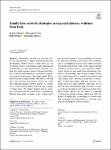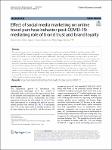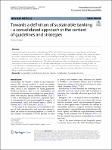Search
Author
- Osman, Ahmed I. (5)
- Daqing, Ma (3)
- Jorgensen, Ed (3)
- Li, Yan (3)
- next >
Subject
- kinh tế (26)
- Economics (12)
- programming (10)
- XRD (10)
- next >
Date issued
- 2020 - 2025 (2128)
- 2010 - 2019 (129)
- 2000 - 2009 (9)
- 1999 - 1999 (1)
Has File(s)
Search Results
Knowledge networks in regional clusters are fundamental to support innovation and local development. Within clusters, family firms are key in creating business opportunities and supporting the establishment of inter-organizational networks. Yet, their role within regional clusters for knowledge transfers is still not well understood, especially in comparison with non-family firms. This paper applies Exponential Random Graph Models (ERGMs) to network data collected from the Parabiago cluster, one of the most important Italian footwear clusters, to contribute to a better understanding of the network strategies of family firms. We identify distinct network strategies associated with the cluster firms, accounting for different knowledge exchange types: technological, market, and manager... |
The present study intends to unleash the influence of social media marketing (SMM) on purchase intention (PI), brand trust (BT) and brand loyalty (BL) in the setting of online travel booking websites. It also analyses the mediating effect of BT and BL in the relationship between SMM and PI. This study also examines the importance of trust and loyalty in the suggested model, which adds to the current research in this area. A self-administered questionnaire was employed to collect the data from the users of online travel booking websites, and the study rested upon 397 valid responses. Data were analyzed using partial least squares structural equation modeling (PLS-SEM) through Smart PLS v.3.2.6. The findings reveal that SMM has a favorable and substantial impact on BT and BL, influenc... |
In this paper, we present a sustainable closed-loop supply chain network equilibrium problem for collectible items in a time-dependent framework. In particular, we consider a network consisting of manufacturers, retailers, demand markets, and an online second-hand platform involved in forward and reverse logistics competition. Manufacturers as well as retailers try to control the amount of emissions generated in transaction processes. We analyze the optimal behaviors of all the decision-makers, and we give the governing closed-loop supply chain network equilibrium conditions. Then, we introduce the associated evolutionary variational inequality and the related infinite-dimensional projected dynamical system, which are convenient to solve such a problem. Finally, using a discrete-tim... |
The first purpose of this paper is to propose a theoretically new robust filter method to estimate non-observable macroeconomic indicators. The second purpose is to apply the proposed method to estimate the Hungarian potential GDP in 2000–2021. The novelty of the proposed filter method is that — unlike papers published so far — it does not require the stability of the dynamic model, only a partial stability condition must be satisfied. Moreover, such time-dependent uncertainties and nonlinearities can arise in the model that satisfy a general quadratic constraint. An important advantage of the proposed robust filter method over the traditional Kalman filter is that no stochastic assumptions is needed that may not be valid for the problem at hand. The proposed filter method has never... |
The income gap is the negative margin between earned income and operating expenses: this is the main financial concern for not-for-profit entities (both public sector and nongovernmental organizations). Despite this, all over the world these entities are forced to use the standard profit-centered income statements format, with its focus on net income generation (the bottom line). This paper proposes an income statement format that uses the income gap to understand/discuss/present the financial viability of a not-for-profit entity in the arts sector, specifically a museum. We apply the framework to the British Museum’s income statements from 1999–2000 to 2018–2019. This allows us to analyze institutional narratives in the context of the evolution of the museum’s financial viability o... |
Sustainable human resource management (SHRM) views employees as a very important resource for the organisation, while paying close attention to their preferences, needs, and perspectives. The individual is an essential element of SHRM. The article focuses on analyzing selected SHRM issues related to the individual employee's level of job engagement and employee satisfaction. The main objective of our study was to identify individual-level correlations between factors affecting employee satisfaction, such as: workplace well-being, employee development, employee retention, job engagement, and employee satisfaction. Based on the results of a systematic literature review, we posed the following research question: is there any relation between factors affecting employee satisfaction (emp... |
Australian Red Cross Lifeblood collects blood from non-remunerated voluntary donors. Thus, it is important to ensure that donors experience good service so they will return to donate blood again. Donor experience is adversely influenced by prolonged waiting times, but they may be reduced by determining the staffing demand over the day. In this paper, we propose a Monte-Carlo simulation-based simulated annealing algorithm that seeks the minimum number of employees to meet demand over a single day while ensuring the system’s predicted average waiting time does not exceed a specified threshold. To enhance the efficiency of our simulated annealing algorithm, we develop a novel neighbourhood search method based on the staff occupancy levels. We use data from four different Australian Red... |
Music is the background of life, representing an international language that connects different cultures. It is also significant with respect to economies, markets, and businesses. The literature in the music field has identified several issues related to the role of digitalization in the revolution of music, the distribution of music products, the management and organization of music events, music marketing strategies, and the position of musicians as entrepreneurs. This paper comprises a systematic literature review of the most recent articles discussing the numerous connections between music, business, and management (2017–2022). Through a rigorous protocol, this research discusses the effects of the digital revolution on the music industry, with particular reference to the persi... |
Sustainable development efforts, initiated by the SDGs and the Paris Agreement on climate change, are bringing banking to the center of the debate, which calls for, among other things, sustainable banking. In the current academic discussion, sustainable banking is described as a terminological jungle that is subject to change over time. Using Webster and Watson’s conceptual model, this review analyzes the definitions and conceptual descriptions used in academia to present a consolidated result. The definition analysis conducted in this paper shows that definitions used mostly refer to the implementation of social, environmental aspects in the respective business strategies and / or to the offering of sustainably labeled products. This paper also shows that the various forms of the d... |
This paper investigates the resilience of small and medium-sized enterprises (SMEs) in relation to the COVID-19 pandemic, particularly the influence exerted by certain factors related to management control, integrated information systems (enterprise resource planning [ERP]), information and communication technology (ICT) systems, and financial resources. For this purpose, leveraging from the dynamic capability theory, in late spring 2020, a questionnaire was sent to limited-liability SMEs in Verona and Vicenza provinces in Italy operating in the manufacturing, construction, and distribution sectors. Respondents were asked to answer a set of questions and to evaluate the resilience of their firms as of January 1, 2020; May 1, 2020; and one year later, as of July 2021. |










